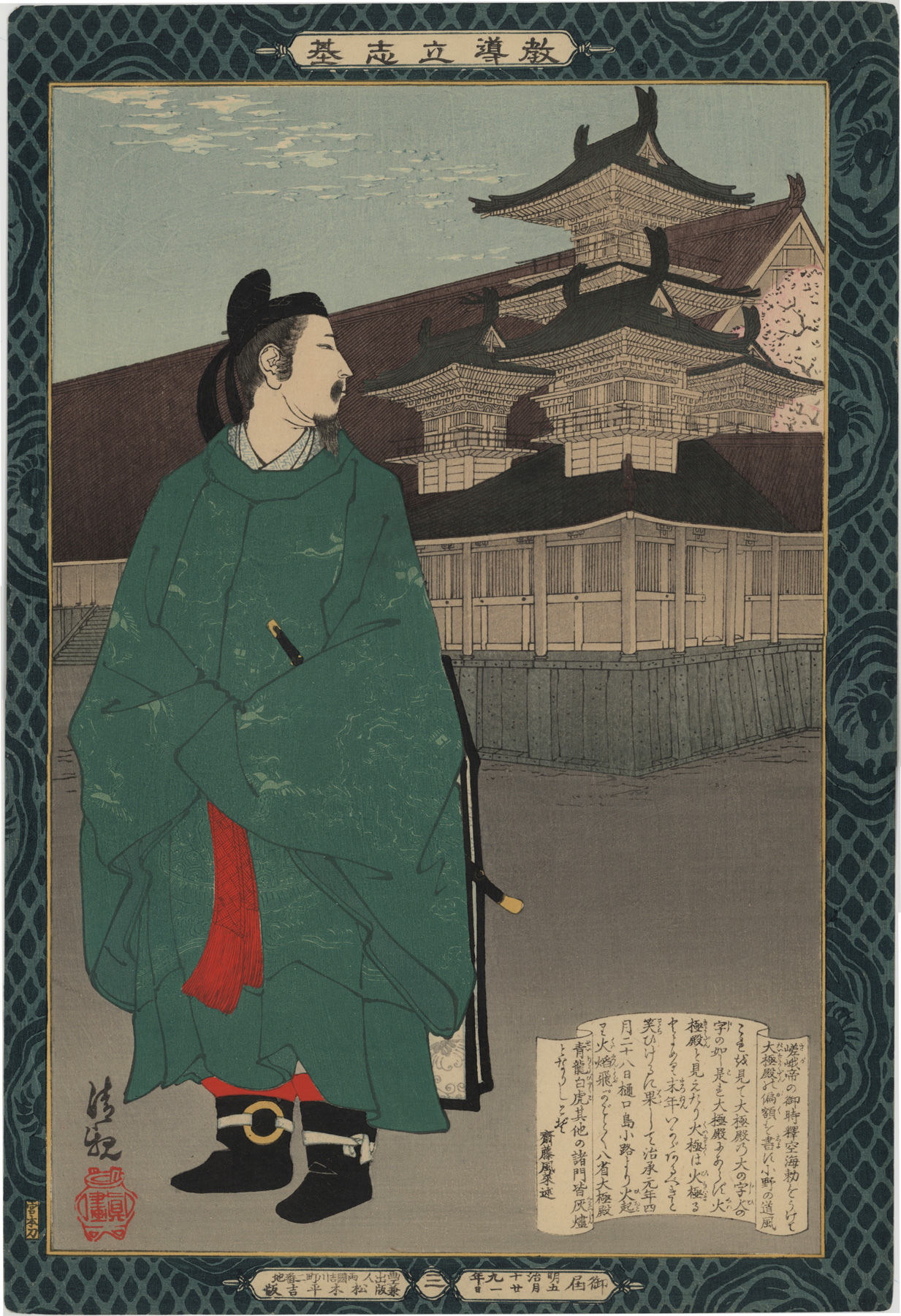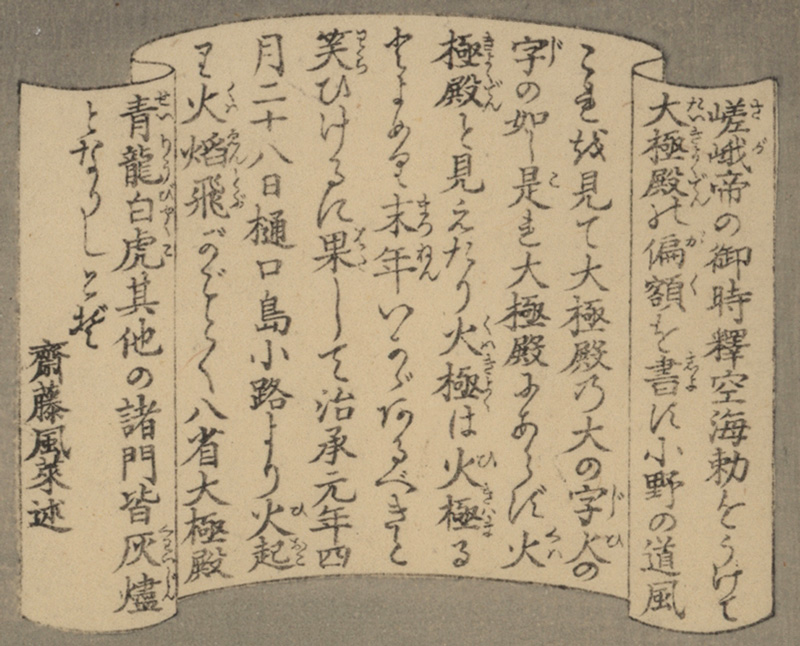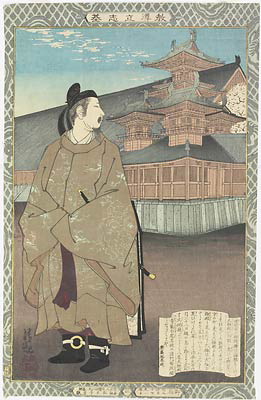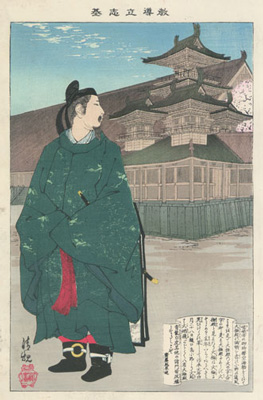About This Print
Print number 三 (3)1 in the series Instructive Models of Lofty Ambition picturing the calligrapher Ono no Tōfū (894-966) in front of the Daigokuden in the Heian Palace complex.Kiyochika contributed 20 prints to this series. As Smith states: "Thestyle of Kiyochika’s offerings to Instructive Models of LoftyAmbition was decorous and even stiff, as befitted the didacticemphasis of the whole [series.]"2
1 Numbering of the prints was haphazard during the production of the series. Print numbers were sometimes inadvertently omitted; some prints in the series were never assigned numbers and a few of the same numbers appear on different prints.
2 Kiyochika Artist of Meiji Japan, Henry D. Smith II, Santa Barbara Museum of Art, 1988, p. 74.
Ono no Tofu
Source: Kiyochika Artist of Meiji Japan, Henry D. Smith II, Santa Barbara Museum of Art, 1988, p. 74-75| One ancient historical figure depicted by Kiyochika in this series [Instructive Models of Lofty Ambition] is Ono no Tofu, a courtier of the Heian period who lived from 894 to 966 and is considered one of Japan’s greatest calligraphers. Curiously, he is not shown here in the didactic pose for which he was best known, learning the lesson of perseverance by watching a frog trying to leap to the branch of a willow tree. Rather, Kiyochika illustrates an anecdote in which the self-confident Tofu criticized the calligraphy of Kobo Daishi, the great Buddhist priest of a century earlier whose perfection with the writing brush is literally proverbial: “Even Kobo makes a slip of the brush: is the equivalent of “Even Homer nods.” The text, contained in the scroll-like cartouche, by Saito Furai (whose identity is unknown) tells the story: |
| In the reign of Emperor Saga (809-823), Kukai (Kobo Daishi) had been requested to inscribe a signboard for the Daigokuden (Great Audience Hall). Ono no Tofu saw this and noted that the character “dai” (great) looked like the character “ka” (fire), so that the meaning was changed to “Court of Consuming Fire”; he laughed, wondering what this might bode for the future. Sure enough, on the twenty-sixth day of the fourth month in the first year of Jisho (1177), fire broke out in Higuchijima Koji, and the flames spread to the Eight Ministries, the Daigokuden, and to the Gates of the Blue Dragon and White Tiger, reducing all to ashes. |
| Kiyochika shows Ono no Tofu in his court robes beside the Daigokuden, in which affairs of state were conducted in Tofu’s time. Since the hall was never rebuilt after its destruction in 1177, Kiyochika had only textual descriptions on which to base his rendering. As it happened, a replica of the building (but much smaller in size) was constructed in Kyoto as the centerpiece of the new Heian Shrine just a decade later, in 1893-95. If the shrine replica is accurate, Kiyochika seems to have telescoped into a single structure both the main hall of the Daigokuden itself and one of the towers that lay to either side of the courtyard. The artist seems more accurate, however, in showing the roof as tiled in azure and the roof finials as gilt bronze, thus capturing the lavish splendor for which the building was known. In the foreground, the famous calligrapher, dressed in court robes, looks back with a hint of the arrogance that the story implies – rather surprising for a model to be emulated. |
Transcription of Scroll
教導立志基 小野の道風 小林清親 1886年5月21日
Transcription: [scroll text by Saitō Furai 齋藤風萊]
“嵯峨帝の御時 釋空海勅をうけて大極殿の偏額を書す 小野の道風これを見て 大極殿乃大の字火の字の如し是れ大極殿にあらず火極殿と見えたり火極(くハきよく)は火極(ひきハま)るとよめり 末年いかゞあるべき と笑ひけるに果して治承元年四月二十八日樋口島小路より火起り火焔飛がごとく八省大極殿青龍白虎其他の諸門皆灰燼となりしとぞ 齋藤風萊 述”
Variant Edition and Later Reissue with Changed Border
About The Series "Kyōdō risshi no motoi"
Notes:1. This series is variously translated as "Instructive Models of Lofty Ambition," "Foundations of Learning and Achievement," "Foundation of Instruction and Perseverance," "Self-Made Men Worthy of Emulation," "Paragons of Instruction and Success," "Moral of Success," "Examples of Self-Made Leaders," and "Instruction in the Fundamentals of Success." The title in Japanese is sometimes seen as "Kyōdō risshiki or "Kyōdō risshi no moto," in addition to the most commonly seen transliteration of "Kyōdō risshi no motoi".
2. For a complete listing of all the prints in the series and additional information please see the article on this site titled Instructive Models of Lofty Ambition.
This series ran between October 1885 and November 1890 and featured a long list of heroes and heroines, from antiquity to contemporary times, who were regarded as standards of moral leadership and self-realization.
Source: Kiyochika Artist of Meiji Japan, Henry D. Smith II, Santa Barbara Museum of Art, 1988, p. 74-75; original research and as footnoted.
This series of 58 prints,1 plus a table of contents sheet (目録), were originally published between October 1885 and November 1890 by the Tokyo publisher Matsuki Heikichi 松木平吉.2 The table of contents sheet issued by the publisher states that "fifty prints make up the complete set (五十番揃)". Three prints not in the initial release were added over the five year publication period, as were five redesigns of original prints, eventually increasing the total print count to 58. The seven artists contributing prints were Kobayashi Kiyochika (1847-1915) [20 prints], Mizuno Toshikata (1866-1908) [16 prints], Inoue Tankei (Yasuji) (1864-1889) [13 prints], Taiso (Tsukioka) Yoshitoshi (1839-1892) [5 prints], Yōshū Chikanobu (1838-1912) [2 prints], Toyohara Kunichika (1835–1900) [1 print], and Hachisuka (Utagawa) Kuniaki II (1835-1888) [1 print]. All the artists, with the exception of Yōshū Chikanobu, are listed in the top scroll of the table of contents sheet. Various colors (including blue, blue/green, and tan/brown) were used for the decorative border, and in 1902 the series was re-issued by Matsuki without borders.
This series of 58 prints,1 plus a table of contents sheet (目録), were originally published between October 1885 and November 1890 by the Tokyo publisher Matsuki Heikichi 松木平吉.2 The table of contents sheet issued by the publisher states that "fifty prints make up the complete set (五十番揃)". Three prints not in the initial release were added over the five year publication period, as were five redesigns of original prints, eventually increasing the total print count to 58. The seven artists contributing prints were Kobayashi Kiyochika (1847-1915) [20 prints], Mizuno Toshikata (1866-1908) [16 prints], Inoue Tankei (Yasuji) (1864-1889) [13 prints], Taiso (Tsukioka) Yoshitoshi (1839-1892) [5 prints], Yōshū Chikanobu (1838-1912) [2 prints], Toyohara Kunichika (1835–1900) [1 print], and Hachisuka (Utagawa) Kuniaki II (1835-1888) [1 print]. All the artists, with the exception of Yōshū Chikanobu, are listed in the top scroll of the table of contents sheet. Various colors (including blue, blue/green, and tan/brown) were used for the decorative border, and in 1902 the series was re-issued by Matsuki without borders.
Brief texts contained within a scroll-like cartouche appearing on each print provide historical details. The scroll composer's name is given at the end of the scroll text. The “lofty ambition” of the title is a Confucian concept, originally from Mencius, meaning “righteous determination that would inspire others.” The market for the series probably included former samurai, ambitious youth, and conservative intellectuals.
"[W]hen it was completed in 1890 the publisher was singled out for special recognition by the government for having sponsored such noble subject matter."3
1 The Tokyo Metropolitan Library online collection shows 50 prints and a Table of Contents sheet. The Table of Contents lists the titles of 50 prints. Smith in Kiyochika Artist of Meiji Japan identified 52 prints. I have identified 58 prints from this series including five prints (Ikina, Michizane Sugiwara, Kesa Gozen, Soga Brothers and Hokiichi Hanawa) that were re-designed and re-printed, likely due to damaged or lost blocks.
2 Robert Schaap notes in Appendix II, p. 166 of Yoshitoshi, Masterpieces from the Ed Freis Collection, Chris Uhlenbeck and Amy Reigle Newland, Hotei Publishing, 2011 that the series originally appeared as newspaper supplements.
3 The World of the Meiji Print: Impressions of a New Civilization, Julia Meech-Pekarik, Weatherhill, 1986, p. 122.
Print Details
| IHL Catalog | #40 |
| Title or Description | Ono-no Tofu 小野道風 Misreading the Title of the Palace |
| Series | “Instructive Models of Lofty Ambition” (Kyodo risshiki 教導立志基) [note: seriestitle also listed as 'Kyodo Risshi no Moto', ‘Kyodo risshi no motoi’,‘Kyōdō risshi ki’ and variously translated as “Moral of success” or“Foundations of learning and achievement” or “Self-made Men Worthy ofEmulation”' or “Examples of Self-made Leaders” or "Paragons of instruction and success"] |
| Artist | Kiyochika Kobayashi (1847-1915) |
| Signature |  |
| Seal | Shin ga 真画 (as shown above) |
| Publication Date | May 21, 1886 |
| Publisher | Matsuki Heikichi (松木平吉) proprietor of Daikokuya Heikichi [Marks: seal not shown; pub. ref. 029] |
| Engraver |  |
| Impression | excellent |
| Colors | excellent |
| Condition | good - Japanese album backing paper; very minor marks and flaws; corners slightly rounded |
| Genre | ukiyo-e; rishki-e; kyōiku nishiki-e |
| Miscellaneous | print number 3 (三); position 3 in the Table of Contents for the series |
| Format | vertical oban |
| H x W Paper | 14 x 9 3/8 in. (35.6 x 23.8 cm) |
| H x W Image | 12 1/2 x 8 1/4 in. (31.8 x 21 cm) area inside brocade border |
| Literature | Kiyochika Artist of Meiji Japan, Henry D. Smith II, Santa Barbara Museum of Art, 1988, p. 74, fig. 83 |
| Collections This Print | Santa Barbara Museum of Art1986.31.63; Scripps College 2005.1.65; Minneapolis Institute of theArts 96.146.234 (variant edition, see above); Tokyo Metropolitan Library 280-K011; Smithsonian National Museum of Asian Art S1995.116.3; British Museum 1906,1220,0.1817 |





